Physical Address
304 North Cardinal St.
Dorchester Center, MA 02124
Stroke is the third commonest cause of death and is a major cause of neurological disability. It is defined as an acute loss of focal cerebral function with symptoms exceeding 24 hours (or leading to death), with no apparent cause other than a vascular origin. A transient ischaemic attack (TIA) has the same definition but lasts <24 hours. In the UK, the annual incidence of stroke is 2:1 000 and 150 000 patients will suffer their first stroke each year. Although mortality has diminished by about 20%, attributed to improved survival rather than a declining incidence, overall stroke incidence could increase by 30% by 2033 because of the ageing population. About 36 000 patients suffer a TIA each year, giving an annual UK incidence of 0.5:1 000.
About 80% of strokes are ischaemic and 20% are haemorrhagic (intracerebral/subarachnoid). Approximately 80% of ischaemic strokes affect the carotid territory. Risk factors include increasing age, smoking, hypertension, ischaemic heart disease, cardioembolic source, previous TIA, diabetes, peripheral artery disease (PAD), high plasma fibrinogen and hypercholesterolaemia.
The Trial of ORG 10172 in Acute Stroke Treatment (TOAST) classification of TIA/ischaemic stroke includes five categories: (1) large artery atherosclerosis with ≥50% stenosis of an extracranial or intracranial artery; (2) cardioembolic; (3) small vessel occlusion (e.g., caused by lipohyalinosis, microatheroma); (4) stroke of other determined aetiology (e.g., arteritis, dissection) and (5) stroke of undetermined aetiology (e.g., two potential causes, no cause identified, or incomplete investigations.
Commonest cause is thromboembolism from a stenosis at the origin of the internal carotid artery (ICA) ( Fig. 10.1 ). Haemodynamic failure accounts for <2% of strokes. Stenoses develop at the ICA origin because of a region of low shear stress, flow stasis and flow separation that predisposes towards atherosclerotic plaque formation. If the plaque undergoes acute disruption (rupture, ulceration, haemorrhage), the core of sub-endothelial collagen is exposed, triggering thrombus formation and secondary embolism.
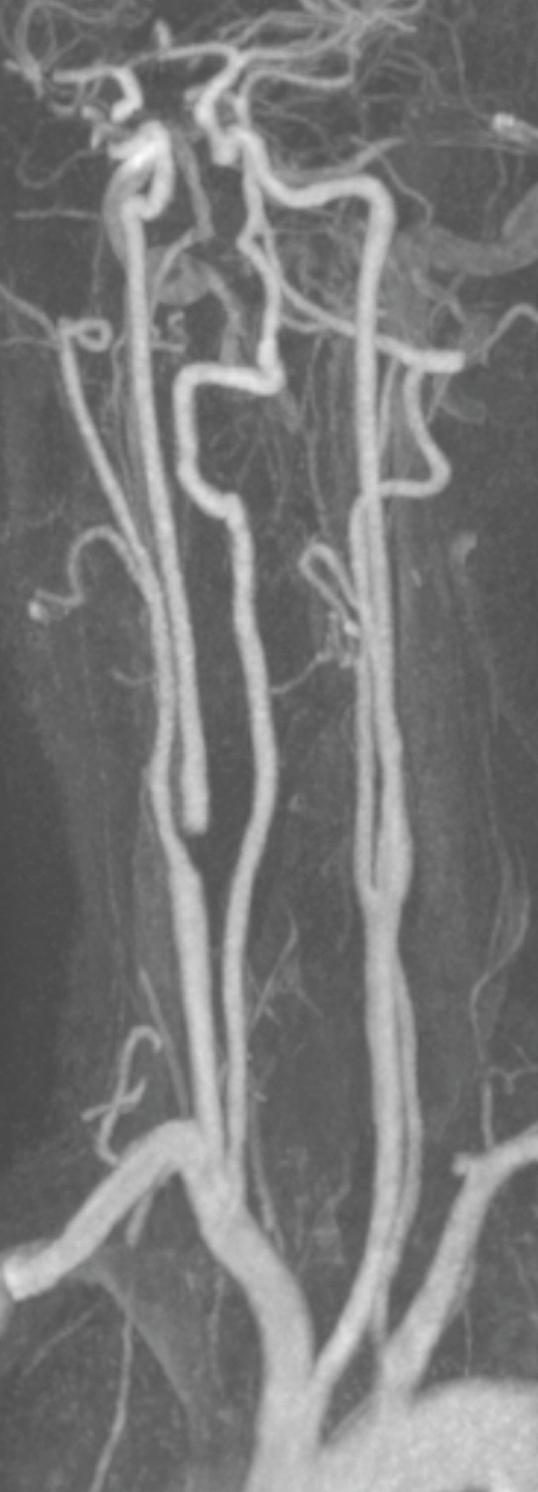
Occlusion of penetrating end-arterioles causes lacunar infarcts. The occlusive process follows fibrinoid necrosis (hypertensive encephalopathy), lipohyalinosis, micro-atheroma (chronic hypertension) or microcalcinosis (diabetes). The commonest sites for lacunar infarction include the basal ganglia, thalamus and internal capsule.
Sources include ventricular mural thrombus (post-myocardial infarction [MI], cardiomyopathy), left atrial thrombus (atrial fibrillation) and valvular lesions (vegetations, prostheses, calcified annulus, endocarditis).
Myeloma, sickle-cell disease, polycythaemia, the oral contraceptive pill and related prothrombotic disorders predispose towards stroke.
Fibromuscular dysplasia (FMD) is a rare disorder of unknown aetiology affecting the renal (60–75%) and carotid arteries (25–30%) in young to middle-aged women. The commonest presentation is hypertension. FMD is classified as: (i) intimal fibroplasia, (ii) medial dysplasia (medial fibroplasia, perimedial fibroplasia, medial hyperplasia) and (iii) adventitial (peri-arterial) fibroplasia. The commonest is medial fibroplasia (75–80% of cases), characterised by alternating stenotic webs and dilatation/aneurysm formation ( Fig. 10.2 ). In up to 60%, FMD is bilateral. Patients with carotid FMD may be asymptomatic or symptomatic (TIA/stroke, dissection, false aneurysm). Management is conservative in asymptomatic individuals, but surveillance is recommended. Once symptomatic, patients should be treated as for symptomatic atherosclerotic disease. Options include resection and interposition bypass, open graduated internal dilatation or (more commonly) percutaneous angioplasty.
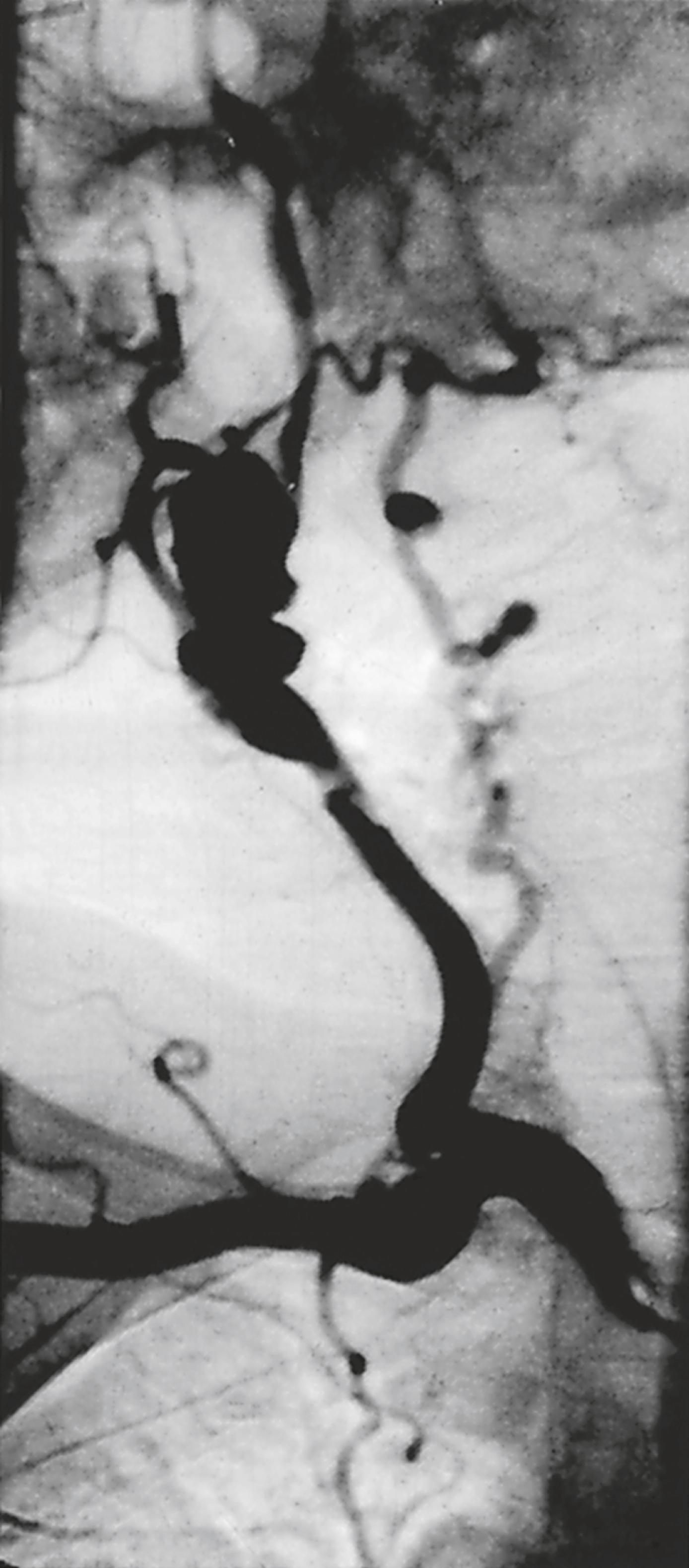
A carotid web (thought to be an intimal variant of FMD) can occasionally be found in the carotid bulb and creates a pocket for local thrombus accumulation and secondary brain embolisation ( Fig. 10.3a –d). A systematic review identified 37 studies involving 158 patients (median age 46 years; 68% female; 76% symptomatic). In the symptomatic cohort, 56% of those who were initially treated medically suffered a recurrent stroke at a median of 12-months after symptom onset. Treatment requires a high degree of suspicion and most symptomatic cases are now treated surgically by resection of the web plus patching or segmental resection and anastomosis.
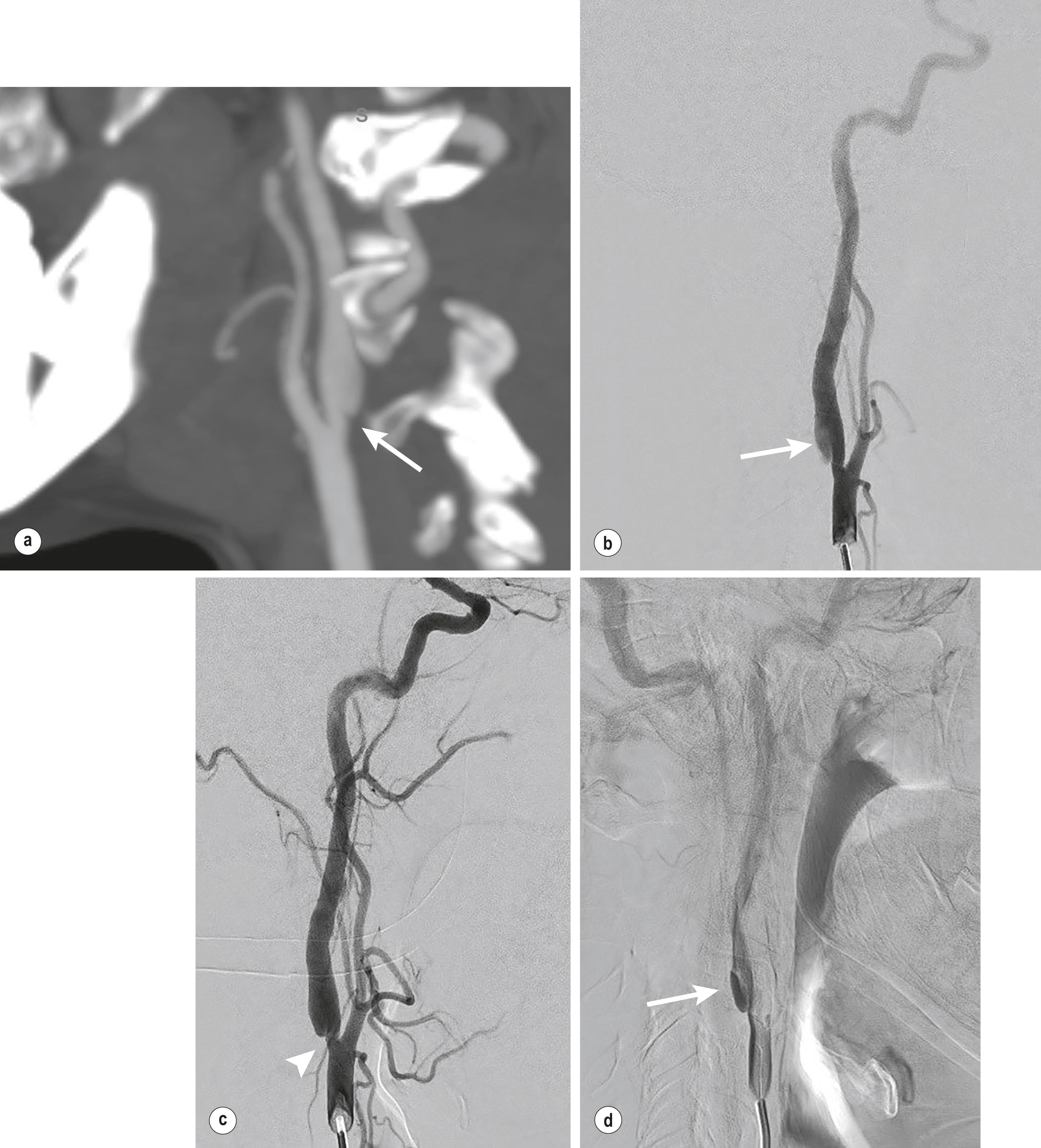
Takayasu’s arteritis (TA) is a transmural, granulomatous inflammatory condition, ultimately causing occlusion through fibrosis. TA predominantly affects younger females (female:male ratio 7:1) and presentation may be a relatively innocuous illness comprising malaise, fever and arthralgia/myalgia. In the acute phase, there is a granulomatous vasculitis with medial disruption, followed by transmural fibrosis. Occasionally, focal aneurysms form after disruption of the internal elastic lamina and media. Neurological symptoms follow vessel occlusion or via renovascular hypertension. Type I TA (arch branches) and Type IIa (ascending aorta, aortic arch, arch branches) present with cerebral vascular/ocular symptoms or asymptomatic stenoses. Type III TA (arch vessels plus abdominal aorta and its branches) accounts for 65% of cases and is associated with stroke, renovascular hypertension and mesenteric ischaemia.
The mainstay of treatment is immunosuppression (steroid/cyclophosphamide/methotrexate). Surgery should be avoided in the acute phase where possible. Neither endarterectomy nor angioplasty/stenting is really an option with involvement of the carotid vessels because of the long segments of fibrotic disease. If surgery becomes necessary, bypass is the preferred option, and the inflow should be taken from the ascending aorta (as opposed to the subclavian artery) as the latter may be involved in the disease process.
Giant-cell arteritis (GCA) is the most common vasculitis in adults and primarily affects older females (female:male ratio 4:1). There are three recognised subtypes (systemic inflammatory syndrome; cranial arteritis and large vessel arteritis). The intracranial vessels are unaffected. The commonest presentation is malaise, headache and myalgic pain. Jaw claudication occurs in 50%, while 50% will develop pain over the temporal artery. Stroke is rare, the commonest presentation being transient/permanent blindness. Ocular symptoms (blindness, corneal ulcers/cataracts) can occur up to 6 months after initial presentation. Treatment is corticosteroid therapy.
Carotid aneurysms are rare (<2% of peripheral aneurysms, 0.2% of all carotid interventions). The accepted definition is a diameter >150% of the common carotid artery (CCA) or twice the diameter of the distal ICA. The aetiology is unknown but may be ‘atherosclerotic’ or follow trauma/infection. Presentations include pulsatile swelling (with/without pain), Horner’s syndrome, thrombosis, dissection, rupture or embolisation (TIA/stroke). Treatment involves exclusion and primary re-anastomosis or interposition bypass. Endovascular exclusion is the preferred option in patients with distal ICA aneurysms.
Acute carotid dissection causes 2% of strokes, increasing to 20% in young adults. One-fifth of trauma patients with an unexplained neurological deficit will have a dissection and 25% will be bilateral. Dissection can be spontaneous (FMD), iatrogenic (angioplasty/stenting), be part of a type A dissection or follow blunt trauma (forced hyperextension or forced rotation with compression of the ICA between the mastoid process and the transverse process of C2). Type I carotid dissections involve irregularity, but no significant stenosis ( Fig. 10.4a ); type II involves a 70–99% stenosis and/or >50% dilatation, while type III dissections present with a characteristic ‘flame’-shaped occlusion about 2–3 cm distal to the bifurcation ( Fig. 10.4b ). The latter is caused by compression of the true lumen by thrombus in the false channel.
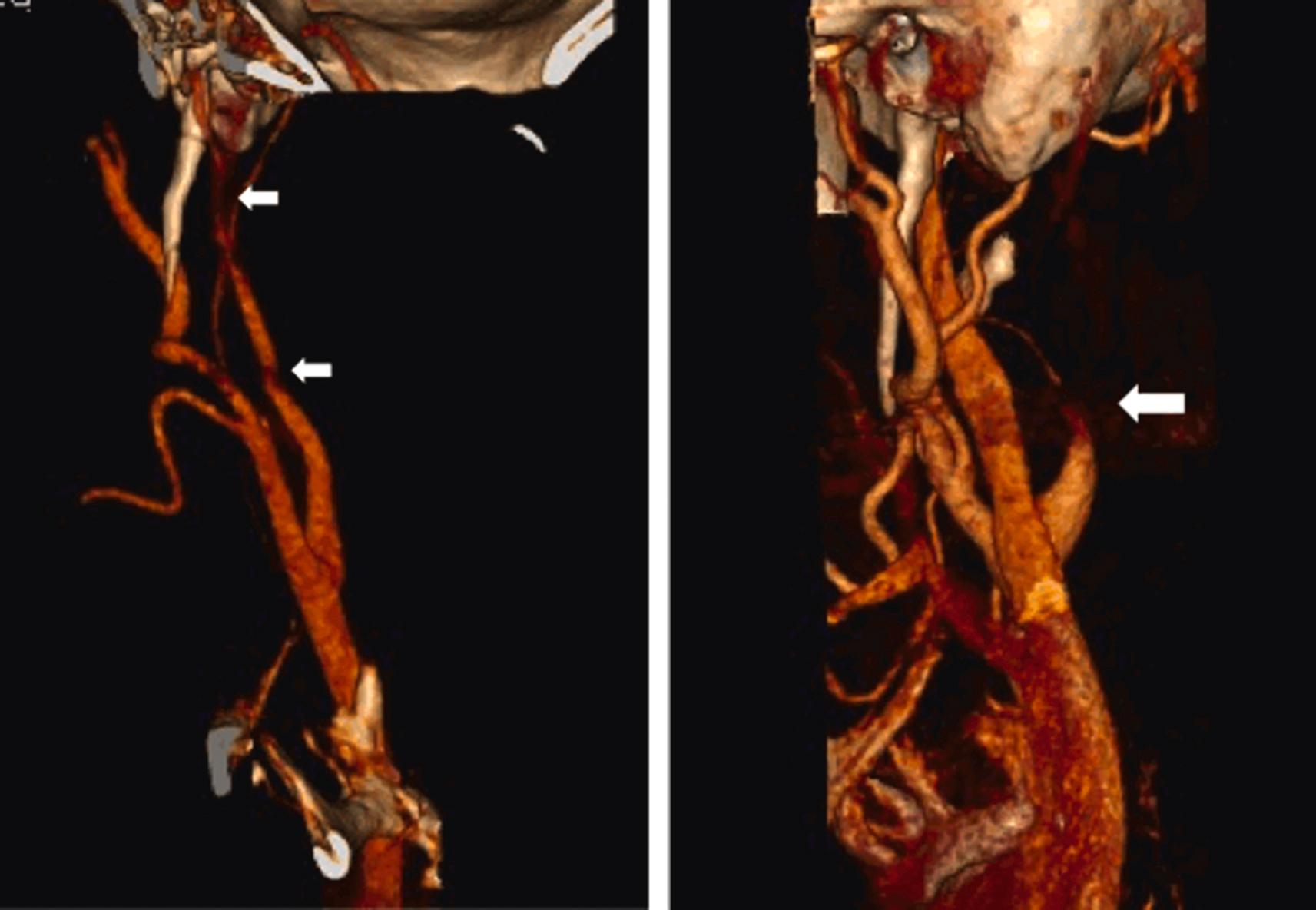
The commonest presentation is ipsilateral head/neck pain (70%), but 50–75% of patients will present with TIA/stroke (usually embolic), pulsatile tinnitus, syncope, ocular signs or cranial nerve palsies (III, IV, VI, VII, IX, X, XII). Cranial nerve signs probably follow mechanical compression from mural haematoma or stretching. Up to 60% with spontaneous dissection will have ocular signs (oculo-sympathetic paresis, amaurosis fugax, aggravated by sitting/standing), hemianopia, ischaemic optic neuropathy and painful Horner’s syndrome). The latter follows segmental ischaemia of the post-ganglionic fibres distal to the superior cervical ganglion and may persist in 50%.
![]() Recognition of ocular symptoms in patients with suspected dissection is important as up to 25% may suffer a stroke within 7 days.
Recognition of ocular symptoms in patients with suspected dissection is important as up to 25% may suffer a stroke within 7 days.
Patients suspected of having an acute dissection should undergo Duplex ultrasound (DUS) and computed tomographic angiography (CTA)/magnetic resonance angiography(MRA) (to include axial T2 fat-saturated images). This typically shows the dissection to start 2–3 cm beyond the origin of the ICA (see Fig. 10.4b ). The distal limit is variable (occasionally the petrous segment) with varying combinations of stenosis, dilatation, intimal flaps and occlusion in the intervening segment. The majority of dissections are managed conservatively. The aim is to reduce the risk of thrombosis and embolism.
![]() Most acute carotid dissections are treated with anticoagulation (heparin then warfarin), but systematic reviews suggest that there is no evidence that this is preferable/safer to antiplatelet therapy.
Most acute carotid dissections are treated with anticoagulation (heparin then warfarin), but systematic reviews suggest that there is no evidence that this is preferable/safer to antiplatelet therapy.
Surgery (or endovascular intervention) is mainly reserved for complex symptomatic trauma cases (usually type II) but may be indicated in patients with recurrent cerebral events despite medical therapy. Overall, dissection carries a 20% mortality and a 30% rate of disability. About 10–40% of dissection patients will develop a false aneurysm, usually in the distal ICA. A systematic review of 166 non-operated distal ICA false aneurysms revealed that in 95% of cases, the false aneurysm either stayed the same size or regressed, while <3% became symptomatic.
![]() Most distal false aneurysms following carotid dissection do not increase in size or cause symptoms. The majority should therefore be managed conservatively. Interventions are only warranted if the aneurysm increases in size or causes symptoms.
Most distal false aneurysms following carotid dissection do not increase in size or cause symptoms. The majority should therefore be managed conservatively. Interventions are only warranted if the aneurysm increases in size or causes symptoms.
The carotid body is located within the adventitia of the posterior aspect of the carotid bifurcation and is responsible for monitoring blood gases/pH. A carotid body tumour (CBT) is derived from cells originating from the neural crest ectoderm (chemoreceptor cells). It is typically located in the space between the ICA and external carotid arteries (ECA) and consists of nests of neoplastic epithelioid chief cells. As it enlarges, the bifurcation splays ( Fig. 10.5a ). In a recent systematic review (104 studies, 4 588 CBTs), mean age at diagnosis was 47 years (1M:2F), 10% were bilateral and 4% were malignant. A palpable neck mass was the presenting symptom in 75% (86% asymptomatic), with cranial nerve palsies and dysphagia being the next commonest presenting symptoms. Stroke/TIA is rarely a clinical presentation (0.4%).
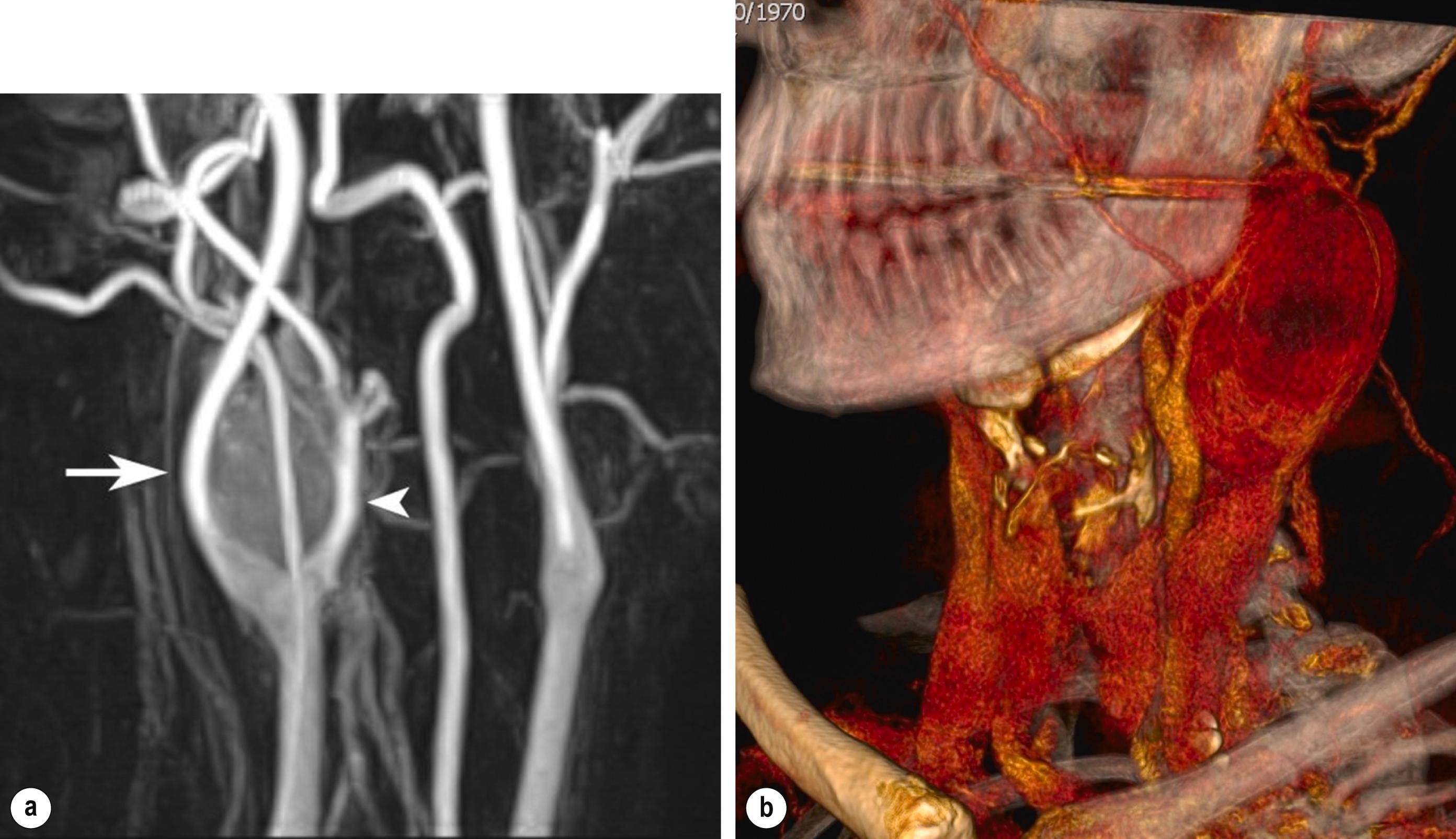
Diagnosis requires awareness, supplemented by DUS, MRA/CTA. Treatment involves excision, although a conservative approach may be preferable in elderly patients with small asymptomatic tumours. Pre-operative embolisation or insertion of a covered stent into the proximal ECA may reduce intra-operative bleeding, but this is probably only necessary with large CBTs. Patients with bilateral CBTs or a family history of CBTs should be referred for testing for mutations of the succinyl dehydrogenase gene as they may be associated with worse disease-free survival after resection in patients with carotid body paragangliomas and may therefore benefit from resection at an earlier stage. Differential diagnoses include glomus vagale/glomus jugulare tumours. A glomus vagale tumour arises from chemoreceptor cells within the vagus nerve and can be differentiated from a CBT because the bifurcation is not splayed. Instead, the tumour causes deviation of the ICA above the bifurcation ( Fig. 10.5b ). It is important to consider a glomus vagale tumour pre-operatively as resection leads to swallowing problems (injury to vagal motor fibres) and hoarseness (recurrent laryngeal nerve) and the patient has to be warned about this. CBT resection is associated with a 4% stroke rate and a 20% incidence of cranial nerve injury (CNI; half permanent). Surgical risks increase as the tumour enlarges and increasingly encircles the bifurcation, ICA and ECA.
Using DUS, the incidence of moderate (>50%) and severe (>70%) asymptomatic carotid stenosis (ACS) in 23 706 people (mean age 61 years, 46% male) recruited from four population-based studies was 2.0% and 0.5%, respectively. The prevalence of >70% ACS increases with age. In males aged 50–59 years it is 0.7%, increasing to 2.1% at age 70–79 years. The respective prevalences for females are 0.5% and 1%.
‘Classical’ carotid territory symptoms include: (1) hemimotor/sensory signs, (2) transient monocular blindness (TMB) and (3) higher cortical dysfunction ( Box 10.1 ). TMB usually develops over a few seconds and clears within a few minutes. Failure to resolve within 24 hours is analogous to a stroke.
![]() A history of TMB in the absence of a source of embolisation should prompt urgent referral to an ophthalmologist to exclude anterior ischaemic optic neuropathy (microvascular disease of the posterior ciliary arteries), which causes acute ischaemia of the optic nerve head.
A history of TMB in the absence of a source of embolisation should prompt urgent referral to an ophthalmologist to exclude anterior ischaemic optic neuropathy (microvascular disease of the posterior ciliary arteries), which causes acute ischaemia of the optic nerve head.
Hemimotor/hemisensory signs
Monocular visual loss (amaurosis fugax)
Higher cortical dysfunction (dysphasia, visuospatial neglect etc.)
Bilateral blindness
Problems with gait and stance
Hemi- or bilateral motor/sensory signs
Dysarthria
Homonymous hemianopia
Diplopia, vertigo and nystagmus (provided it is not the only symptom)
Differential diagnoses for carotid territory events include epilepsy, tumour, giant aneurysm, hypoglycaemia and migraine (i.e. stroke mimics). Where TIAs are precipitated by a heavy meal, hot bath, exercise or where there is a ‘limb shaking’ TIA, a haemodynamically critical ICA stenosis should be suspected.
Conventional teaching advises that the risk of stroke after a TIA/minor stroke is 1–2% at 7 days and 2–4% at 30 days. This, in conjunction with a historical reluctance to perform carotid surgery within the early time period after onset of symptoms (concerns about increased procedural risks), has led to little urgency regarding referral, investigation and management. However, there is now compelling evidence that the incidence of recurrent stroke after the index TIA in patients with 50–99% ICA stenoses ranges from 5–8% at 48 hours, 4–17% at 72 hours, 8–22% at 7 days and 11–25% at 14 days. Interestingly, pooled data from patients randomised to ‘best medical therapy’ (BMT) in the European Carotid Surgery Trial (ECST), North American Symptomatic Carotid Endarterectomy Trial (NASCET) and the Veterans Affairs trials observed only a 21% risk of ipsilateral stroke at 5 years in patients randomised to BMT. This would suggest that most patients who were destined to suffer an early recurrent stroke after their TIA were rarely randomised quickly enough within these trials. The decision to refer a recently symptomatic patient should never be influenced by the presence/absence of a carotid bruit.
Vertebrobasilar (VB) symptoms (see Box 10.1 ) include bilateral blindness, problems with gait/stance, hemilateral/bilateral motor or sensory impairment (10% will have hemisensory/motor signs), dysarthria, homonymous hemianopia, nystagmus, dizziness, diplopia and vertigo (provided the latter three are not isolated).
![]() VB TIAs carry early stroke risks comparable to carotid territory events, especially if they have an ipsilateral 50–99% stenosis (20–30% stroke risk within 90 days). Patients reporting VB symptoms need to be treated more urgently in future.
VB TIAs carry early stroke risks comparable to carotid territory events, especially if they have an ipsilateral 50–99% stenosis (20–30% stroke risk within 90 days). Patients reporting VB symptoms need to be treated more urgently in future.
The term ‘non-hemispheric’ is applied to patients with isolated syncope (blackout, drop attack), presyncope (faintness), isolated dizziness, isolated double vision (diplopia) and isolated vertigo.
![]() ‘Non-hemispheric’ symptoms should never be considered to be carotid or VB in origin unless other ‘classical’ symptoms are present. It is very important to exclude a cardiac or inner ear pathology.
‘Non-hemispheric’ symptoms should never be considered to be carotid or VB in origin unless other ‘classical’ symptoms are present. It is very important to exclude a cardiac or inner ear pathology.
Become a Clinical Tree membership for Full access and enjoy Unlimited articles
If you are a member. Log in here